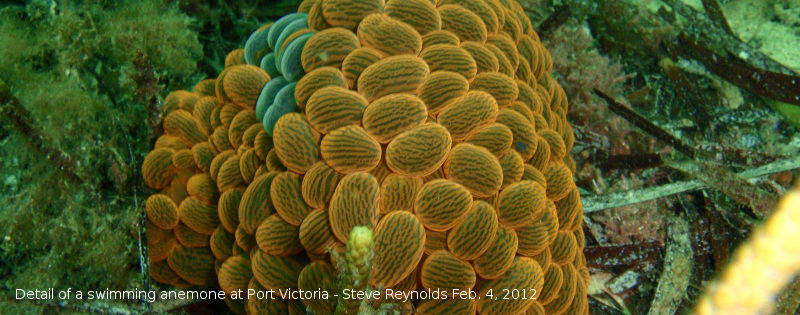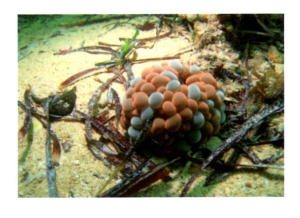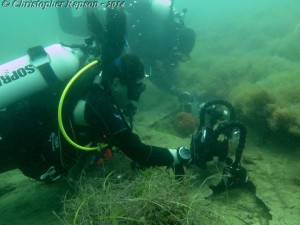The swimming anemone, Phylctenactis tuberculosa, may vary in colour from the usual dull orange-brown to olive, to red-brown, to orange, pale pink and light to dark grey-blue, and often combinations of these colours (according to “A field guide to the marine invertebrates of South Australia” by Karen Gowlett-Holmes).
I took this photo of a swimming anemone at Port Victoria in February 2012: –

Close-up shot of a swimming anemone
(Photo: Steve Reynolds at Port Victoria )
Although these anemones are usually attached to kelp or other weed or rock, they sometimes drift free, hence the common name of ‘swimming’ anemone. Their tentacles are usually retracted during the day but they extend at night for feeding. I scanned this image of some extended tentacles from an old print that I have: –

The extended tentacles of a swimming anemone
(Photo: Steve Reynolds)
I also scanned this image of Dennis Hutson photographing a swimming anemone at Second Valley in 2004 from an old print that I have: –

Dennis Hutson photographing a swimming anemone at Second Valley
(Photo: Steve Reynolds)
Described by Quoy & Gaimard, 1833
The anemone was first described by two French doctors, J.R.C. Quoy and J.P. Gaimard in 1833. Quoy and Gaimard had both doubled as ship surgeons and naturalists on two scientific expeditions which visited Australia. Although they never visited South Australia, they described many fish and invertebrate species that occur in SA.
Their first visit to Australia was in 1818 when they were onboard the ship Uranie under the command of Louis Freycinet. They made many observations on Australia’s wildlife and marine life, and collected lots of specimens. Most of their material was, however, lost when the Uranie was wrecked at the Falkland Islands in 1820 on the voyage home.
In 1826, they returned to Australia onboard the Astrolabe commanded by Count Dumont D’Urville. Most of the large collection of specimens, gathered from the places that they visited, were presented to the Natural History Museum of Paris.
Further details regarding Quoy and Gaimard were published in our January 1984 newsletter in an article titled “Two Early Naturalists”. Also see “Confusion Over The Names Of Two Ships And Two Brothers” by Steve Reynolds, MLSSA Newsletter, November 2004.
Back to the swimming anemone
Now back to the anemone, the classification for the swimming anemone, Phylctenactis tuberculosa is as follows: Phylum: Cnidaria, Class: Anthozoa, Subclass: Hexacorallia, Order: Actiniaria, Suborder: Endocoelantheae, Family: Actiniidae, Genus: Phylctenactis, Species: tuberculosa.
The Atlas of Living Australia shows occurrences of the species reported from temperate waters in New South Wales, Victoria, Tasmania, South Australia and Western Australia, though data points are few. The Marine Life Society of South Australia encourages anyone with an image of this species who is confident of its location and the timing of the image to contribute it to this wonderful national database.
The photo for September in the 2014 MLSSA calendar of SA Marine Life features a swimming anemone!” It was taken by Chris Hall at Wool Bay in 2011.
The September image in the 2014 MLSSA calendar of SA Marine Life
(Taken by Chris Hall at Wool Bay in 2011)
We have just the one image of Phylctenactis tuberculosa in our Photo Index. It is image number 2105, taken by David Muirhead at Mac’s Ground in 1991: –
Image number 2105 in our Photo Index
(Taken by David Muirhead at Mac’s Ground)
Vera Kurz found this beautiful swimming anemone, Phylctenactis tuberculosa, in a rock pool in Guerilla Bay on the southeast coast of New South Wales in 2014: –

Swimming anemone in a rock pool at Guerilla Bay, NSW
(Photo: by Vera Kurz)
Here again is a swimming anemone limerick written by invertebrate blogger Heather Robertson at my request: –
“Many names this anemone’s been called,
from “baked beans” to “wandering beach ball”.
Oh, you clever Phlyctenactis,
with your tentacles retracted,
over the sea floor you roll, swim and crawl.”
Sightings of swimming anemone continue to occur. A couple have been seen during December 2014. This one shown below was photographed by Belinda Battersby between the beach and Lassiters Reef at Second Valley on 27th December: –
Swimming anemone at Second Valley
(Taken by Belinda Battersby)
Belinda saw another one at the wreck of the Norma the very next day (28th December). She took this close-up shot of it: –
Swimming anemone at the Norma
(Taken by Belinda Battersby)
Chris Rapson was diving at the Norma that same day (28th December). He took this photo of a diver photographing a swimming anemone, possibly the same one sighted by Belinda: –
Divers photographing a swimming anemone at the Norma
(Taken by Chris Rapson)
Chris also took his own shots of the anemone, as shown below: –
A swimming anemone at the Norma
(Taken by Chris Rapson)
Chris also took this close-up shot of the anemone: –
Close-up of the swimming anemone at the Norma
(Taken by Chris Rapson)









Our ‘local’ (and probably obligate aka full-time)cleaner shrimp,Periclimenes aesopius,can occasionally be found in association with this large anemone.I’ve a few poor quality old slide images which show this association,but though I’ve scrutinised every ‘swimming anemone’ I’ve seen since going digital in early 2009,I’ve yet to find another such cleaner shrimp,let alone on an anemone @ rest during slack diurnal tides which is when I have most often encountered this anemone.P.aesopius is best observed @ night,eg under Kingscote Jetty,where one can observe it’s distinctive ‘slow dancing up and down and around’ behaviour,which is thought to be it’s way of advertising itself to potential clients.It’s a strikingly patterned and coloured little shrimp,worth keeping on any Southern Oz ecodiver’s bucket list.
A beached specimen of Phylctenactis tuberculosa was found yesterday on Henley Beach. The recent storm probably dislodged it from its rock. Quite a lot of anchored seaweed has also washed up with stones attached. I still have the specimen in salt water although sadly it was DOA to the beach. Happy to send photos if required
Thanks Phill
The photos have now been posted at https://mlssa.org.au/2016/02/06/photos-of-a-beach-washed-swimming-anemone-phylctenactis-tuberculosa/
Cheers
Steve
[…] for his many photos and interest. It seems that he contacted us after reading my article posted at https://mlssa.org.au/2014/12/21/the-swimming-anemone-phylctenactis-tuberculosa/ […]